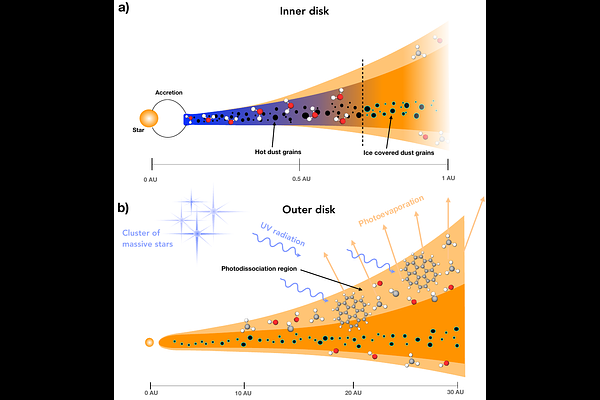Solar C/O ratio in planet-forming gas at 1 au in a highly irradiated disk

Solar C/O ratio in planet-forming gas at 1 au in a highly irradiated disk
Ilane Schroetter, Olivier Berné, Emeric Bron, Felipe Alarcon, Paul Amiot, Edwin A. Bergin, Christiaan Boersma, Jan Cami, Gavin A. L. Coleman, Emmanuel Dartois, Asuncion Fuente, Javier R. Goicoechea, Emilie Habart, Thomas J. Haworth, Christine Joblin, Franck Le Petit, Takashi Onaka, Els Peeters, Markus Rölling, Alexander G. G. M. Tielens, Marion Zannese
AbstractThe chemical composition of exoplanets is thought to be influenced by the composition of the disks in which they form. JWST observations have unveiled a variety of species in numerous nearby disks, showing significant variations in the C/O abundance ratio. However, little is known about the composition and C/O ratio of disks around young stars in clusters exposed to strong ultraviolet (UV) radiation from nearby massive stars, which are representative of the environments where most planetary systems form, including ours. We present JWST spectroscopy of d203-504, a young 0.7 $\rm M_{\odot}$ star in the Orion Nebula with a 30 au disk irradiated by nearby massive stars. These observations reveal spectroscopic signatures of CO, H$_2$O, CH$_3^+$, and PAHs. Water and CO are detected in absorption in the inner disk ($r\lesssim 1$ au), where the estimated gas-phase C/O ratio is 0.48, consistent with the Solar value and that of the Orion Nebula. In contrast, \ch{CH3+} and PAHs are found in the extended surface layers of the disk. These results suggest that gas in the inner disk is chemically shielded from UV radiation while the surface layers of the disk experience UV-induced chemistry, potentially depleting their carbon content.